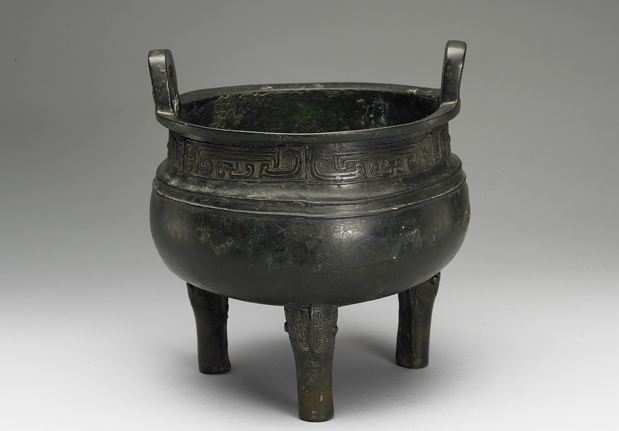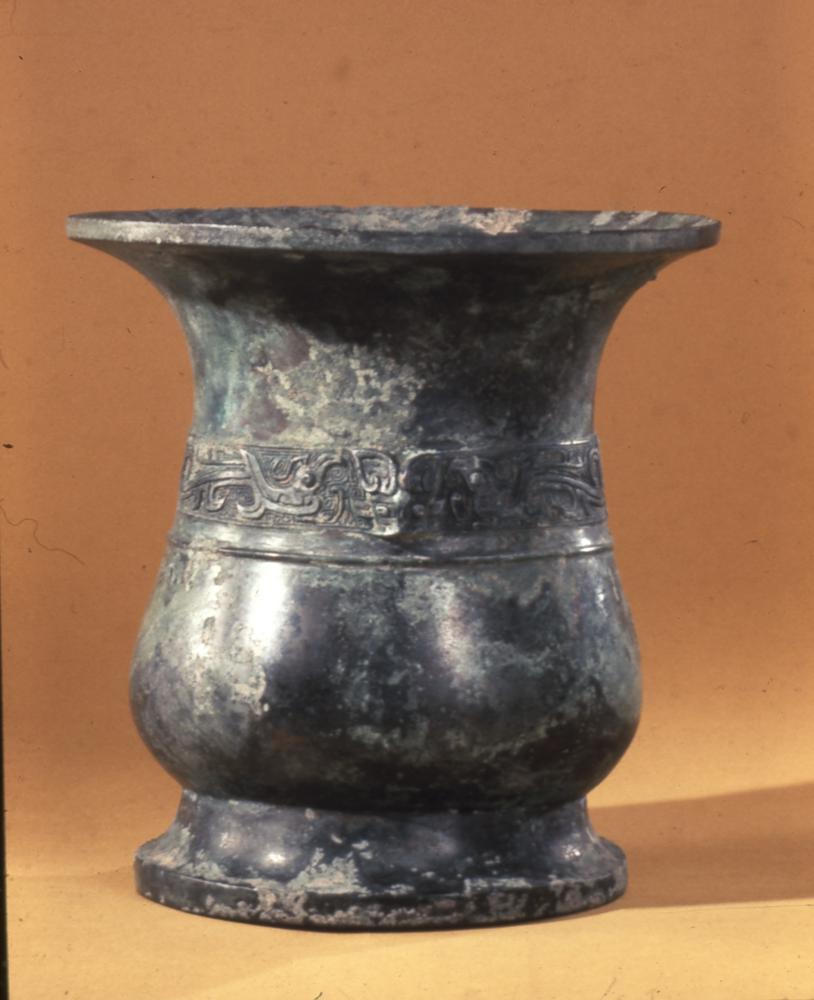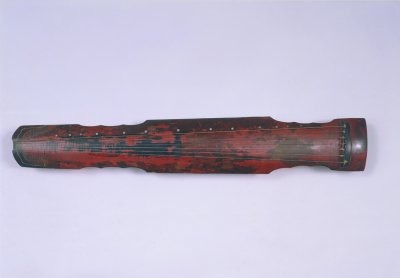Period:Ming dynasty Production date:1506-1521
Materials:porcelain
Technique:glazed, incised, slipped, painted,
Subjects:flaming jewel dragon
Dimensions:Diameter: 23.30 centimetres Height: 10.40 centimetres
Description:
Deep porcelain bowl with both incised and slip decoration, coloured with overglaze green enamel on a yellow ground. This bowl, which has deep rounded sides and an out-turned rim, stands on a high inward-tapering foot. Unlike most porcelains in this group with green designs on a yellow ground, this bowl is not plain inside but is incised. Two prancing dragons are shown in profile, pursuing each other; in between them their flaming pearls float above a ‘ruyi’ cloud. Incised in the centre, within a double ring medallion, two ‘ruyi’ clouds are joined together with an undulating streamer. Outside, instead of being outlined with incised lines, the decoration is delineated in trailed slip and coloured with a mint-green enamel on an uneven deep yellow ground. Two dragons are shown in profile, chasing after flaming pearls separated by three ‘ruyi’ cloud scrolls, with a lappet border below and a raised line around the foot painted in green. Details such as the dragons’ scales, faces and claws are all mapped out with trailed slip. The convex base is marked with four ‘Phags-pa characters in a double ring, arranged rather like a reign mark.
IMG
![图片[1]-bowl BM-1926-1124.1-China Archive](https://chinaarchive.net/Ming dynasty/Ceramics/mid_00256901_001.jpg)
Comments:Harrison-Hall 2001:Much academic debate in China and elsewhere has centred around the interpretation of this ‘Phags-pa mark and consequent dating. ‘Phags-pa script is Mongolian, transcribed in an adaptation of the Uighur alphabet. Developed by ‘Phags-pa (1235-80), an influential Tibetan lama who had a considerable influence on Mongol rulers’ views of politics and religion, it was adopted in 1269 for a short time in the Yuan dynasty as China’s official script of administration, but was quickly dropped. ‘Phags-pa script was not much used in China after the collapse of the Mongol empire, so some scholars believe that such bowls were made during the Yuan era. In support of this theory comparisons are made between the incised cloud motif on the present bowl and those clouds seen on fourteenth-century monochromes. However, the colours, porcelain and potting of this bowl are in fact typical of the Zhengde period. Zhang Ying from the Jilin Provincial Museum and Liu Zhenhua from the Jilin Cultural Relics and Archaeology Institute have suggested that three of the four ‘Phags-pa characters read ‘zheng’, ‘nian’ and ‘zhi’. Potters in Jingdezhen probably did not understand the Mongol script, and so it is difficult to read their interpretation of the mark. We know that ‘Phags-pa was used to transliterate Chinese names at the Longquan kilns long after the language was developed in 1269. There the heterodox nature of the transliterations reflects local non-Mandarin speakers’ pronounciation of surnames.We are familiar with the Arabic- and Persian-inscribed blue-and-white Porcelains with Zhengde reign marks. As the Zhengde emperor had an interest in foreign scripts and languages, it seems likely that he commissioned this bowl. Shike suggests that blue-and-white porcelains, dishes and bowls with this mark were commissioned by the Zhengde emperor to present as gifts to lamas who were invited to live in Beijing during his reign. A shard of a blue-and-white bowl with a four-character ‘Phags-pa mark dating to the Zhengde period has been excavated at Jingdezhen (for a blue-and-white dish with dragons on a lotus ground and with the ‘Phags-pa mark see an example in the Freer Gallery, Washington, illustrated in Pope, Knapp and Atil 1975, cat. no. 109). A similar yellow-and-green dish, also with incised dragons inside, but bearing a Zhengde reign mark, is in the Metropolitan Museum of Art, New York. Another with incised decoration outside in place of raised slip is in the Princessehof Museum, Leeuwarden. These confirm the attribution to the Zhengde period.
Materials:porcelain
Technique:glazed, incised, slipped, painted,
Subjects:flaming jewel dragon
Dimensions:Diameter: 23.30 centimetres Height: 10.40 centimetres
Description:
Deep porcelain bowl with both incised and slip decoration, coloured with overglaze green enamel on a yellow ground. This bowl, which has deep rounded sides and an out-turned rim, stands on a high inward-tapering foot. Unlike most porcelains in this group with green designs on a yellow ground, this bowl is not plain inside but is incised. Two prancing dragons are shown in profile, pursuing each other; in between them their flaming pearls float above a ‘ruyi’ cloud. Incised in the centre, within a double ring medallion, two ‘ruyi’ clouds are joined together with an undulating streamer. Outside, instead of being outlined with incised lines, the decoration is delineated in trailed slip and coloured with a mint-green enamel on an uneven deep yellow ground. Two dragons are shown in profile, chasing after flaming pearls separated by three ‘ruyi’ cloud scrolls, with a lappet border below and a raised line around the foot painted in green. Details such as the dragons’ scales, faces and claws are all mapped out with trailed slip. The convex base is marked with four ‘Phags-pa characters in a double ring, arranged rather like a reign mark.
IMG
![图片[1]-bowl BM-1926-1124.1-China Archive](https://chinaarchive.net/Ming dynasty/Ceramics/mid_00256901_001.jpg)
Comments:Harrison-Hall 2001:Much academic debate in China and elsewhere has centred around the interpretation of this ‘Phags-pa mark and consequent dating. ‘Phags-pa script is Mongolian, transcribed in an adaptation of the Uighur alphabet. Developed by ‘Phags-pa (1235-80), an influential Tibetan lama who had a considerable influence on Mongol rulers’ views of politics and religion, it was adopted in 1269 for a short time in the Yuan dynasty as China’s official script of administration, but was quickly dropped. ‘Phags-pa script was not much used in China after the collapse of the Mongol empire, so some scholars believe that such bowls were made during the Yuan era. In support of this theory comparisons are made between the incised cloud motif on the present bowl and those clouds seen on fourteenth-century monochromes. However, the colours, porcelain and potting of this bowl are in fact typical of the Zhengde period. Zhang Ying from the Jilin Provincial Museum and Liu Zhenhua from the Jilin Cultural Relics and Archaeology Institute have suggested that three of the four ‘Phags-pa characters read ‘zheng’, ‘nian’ and ‘zhi’. Potters in Jingdezhen probably did not understand the Mongol script, and so it is difficult to read their interpretation of the mark. We know that ‘Phags-pa was used to transliterate Chinese names at the Longquan kilns long after the language was developed in 1269. There the heterodox nature of the transliterations reflects local non-Mandarin speakers’ pronounciation of surnames.We are familiar with the Arabic- and Persian-inscribed blue-and-white Porcelains with Zhengde reign marks. As the Zhengde emperor had an interest in foreign scripts and languages, it seems likely that he commissioned this bowl. Shike suggests that blue-and-white porcelains, dishes and bowls with this mark were commissioned by the Zhengde emperor to present as gifts to lamas who were invited to live in Beijing during his reign. A shard of a blue-and-white bowl with a four-character ‘Phags-pa mark dating to the Zhengde period has been excavated at Jingdezhen (for a blue-and-white dish with dragons on a lotus ground and with the ‘Phags-pa mark see an example in the Freer Gallery, Washington, illustrated in Pope, Knapp and Atil 1975, cat. no. 109). A similar yellow-and-green dish, also with incised dragons inside, but bearing a Zhengde reign mark, is in the Metropolitan Museum of Art, New York. Another with incised decoration outside in place of raised slip is in the Princessehof Museum, Leeuwarden. These confirm the attribution to the Zhengde period.
© Copyright
The copyright of the article belongs to the author, please keep the original link for reprinting.
THE END





